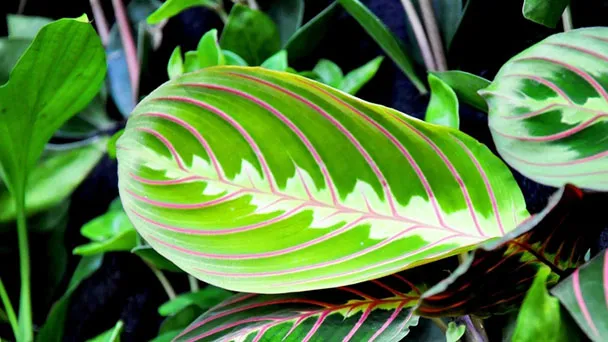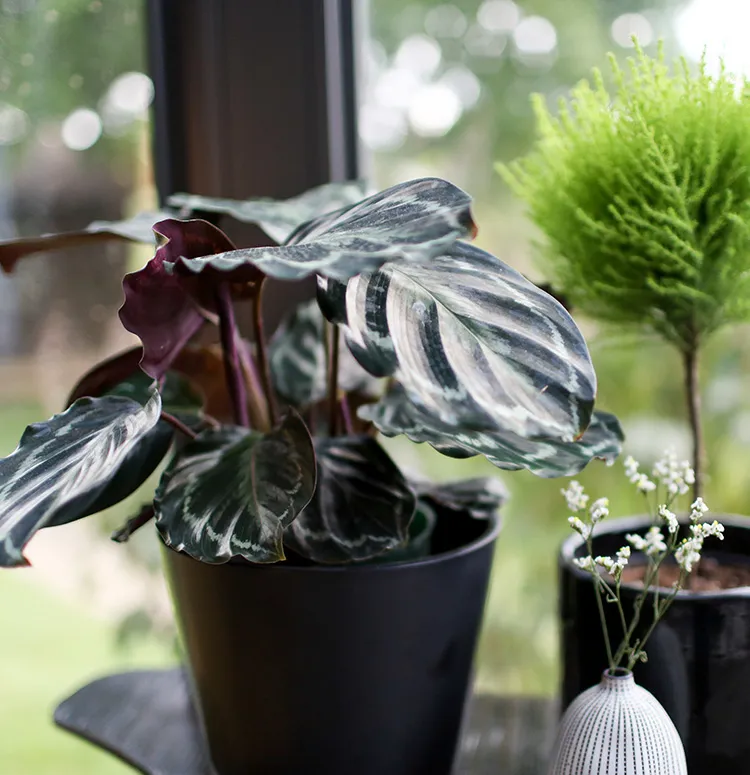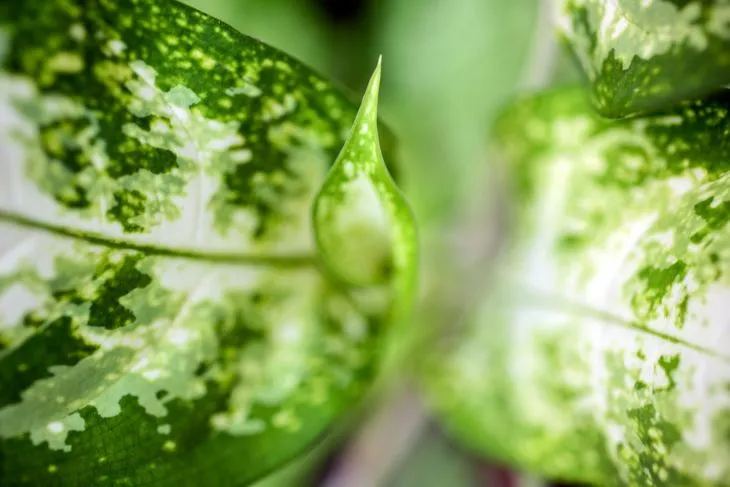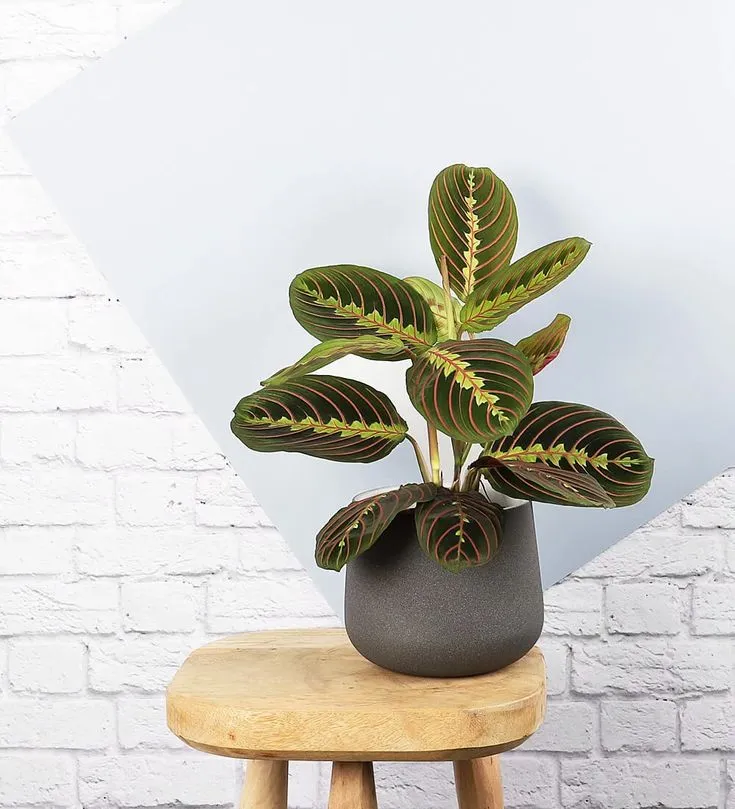Prayer Plant Problems - Prayer Plant Care
Written by Ivy
Nov 17 2022

We may encounter various problems when maintaining the prayer plant, such as spots on the leaves, yellow leaves, etc. Most of the prayer plants are produced in tropical areas, which is also very important. We can know some of their growth habits from this. Let's take a look at these prayer plant problems.
 There are spots on the leaves of peacock prayer plant, which may be caused by leaf spot disease. At the time of onset, yellowish brown spots will appear on the leaves, which are usually easy to occur in a muggy and humid environment. We should take medicine as soon as possible at the early stage of the disease. Carbendazim and thiophanate methyl can be used to treat the diseased leaves. It is best to cut off the prayer plant in time to avoid infecting more leaves.
There are spots on the leaves of peacock prayer plant, which may be caused by leaf spot disease. At the time of onset, yellowish brown spots will appear on the leaves, which are usually easy to occur in a muggy and humid environment. We should take medicine as soon as possible at the early stage of the disease. Carbendazim and thiophanate methyl can be used to treat the diseased leaves. It is best to cut off the prayer plant in time to avoid infecting more leaves.
Read More:
Why Does My Prayer Plant Have Yellow Leaves
Read More:
Complete Prayer Plant (Maranta Leuconeura) Care Instructions
There is another situation that will lead to leaf curling, that is, the quality of water is not good. If you directly use tap water to supplement water to the ornamental prayer plant for a long time. If there is too much salt accumulation in the soil, the leaves of the ornamental prayer plant will wither and fade, and the leaves may curl. This situation is better avoided. Rain water should be used occasionally to replenish water for the ornamental prayer plant; You can also put tap water in a container and use it to replenish water for plants in two or three days. Every month or two, you can use a lot of water to wash the potted soil of the ornamental prayer plant, and also wash away the salt. Most of the prayer plant varieties are native to the tropical regions of America and Asia. It likes a warm and humid environment and is very sensitive to temperature and moisture. It is difficult to raise the prayer plant in winter, mainly because of the cold and dry climate in winter. Southern winter without heating, easy to freeze to death; Although there is heating in winter in the north, the indoor air is very dry, which can easily lead to the problem of withered and yellow leaves in the prayer plant.
Most of the prayer plant varieties are native to the tropical regions of America and Asia. It likes a warm and humid environment and is very sensitive to temperature and moisture. It is difficult to raise the prayer plant in winter, mainly because of the cold and dry climate in winter. Southern winter without heating, easy to freeze to death; Although there is heating in winter in the north, the indoor air is very dry, which can easily lead to the problem of withered and yellow leaves in the prayer plant.
Why are there spots on my prayer plant?Why do my prayer plant leaves turn yellow?Why do my prayer plant leaves droop?Why do my prayer plant leaves curl?1、 Normal rolling2、 Abnormal leaf curlMaintenance of prayer plant in winterPay attention to temperatureApply antifreeze fertilizerLight required in winterWinter watering frequency
Why are there spots on my prayer plant?

Why do my prayer plant leaves turn yellow?
If we want to prevent the leaves of the ornamental prayer plant from turning yellow, we should avoid excessive exposure to the sun, dry air and frequent watering. These are the things we should pay attention to when maintaining the ornamental prayer plant.Read More:
Why Does My Prayer Plant Have Yellow Leaves
Why do my prayer plant leaves droop?
Answer: Prayer plant is a kind of plant that is usually easy to maintain. If the leaves fall, there may be a problem with the basin soil. We should replace it with loose soil suitable for itself. It may also be that the root rot is caused by improper watering and fertilization. The water and fertilizer should be controlled and the water and fertilizer should be applied reasonably. The falling of prayer plant leaves may also be caused by insufficient sunlight. It needs to be placed in a place with good light and not too shady during the growth period.Why do my prayer plant leaves curl?

1、 Normal rolling
The normal curling of the leaves of the ornamental prayer plant is in the completely dark environment at night. For example, we usually keep the ornamental prayer plant in a bright place with appropriate scattered light during the day. At night, the environment becomes completely dark. At this time, its leaves will fall into dormancy and the leaves will appear curly, This is its normal leaf curl.2、 Abnormal leaf curl
1. Excessive sunlight
The ornamental prayer plant itself is a shade tolerant plant, which is afraid of direct sunlight or excessive exposure. If the potted ornamental prayer plant is kept in a place with more light, if the sun is too strong, its leaves will be damaged, and the edge or tip of the leaves will turn brown yellow. The ornamental prayer plant leaves will fade, and even some white patches will appear. In serious cases, the whole leaf will roll up. The solution is very simple, that is, move the potted ornamental prayer plant to a cool place in time. You can give a little soft light in the morning and avoid the sunshine at noon and afternoon. We cut off some of the sunburned leaves, then pour them into the water once, and occasionally spray water, which will gradually restore their health.2. The temperature is too low
This situation will occur in winter and spring when it is not completely warm. The ornamental prayer plant itself is a tropical foliage plant. If the maintenance ambient temperature is too low, for example, the temperature is below 5 degrees, the leaves may be frostbitten, the leaves will curl, and some water stains will appear on the leaf surface, Those are frostbitten leaves. If the potted ornamental prayer plant is not moved to a warmer place in time and the frostbitten stems and leaves are cut off, its roots will be frostbitten and eventually lead to root rot.3. Dry environment
This is the most common reason for the curly leaves of the indoor maintenance potted ornamental prayer plant, because the ornamental prayer plant originally grew in the shade of the tropical rain forest, such as Prayer Plant Maranta Leuconeura, and there is a particularly high environmental humidity around it. If the indoor potted plant is cultivated, the environment is relatively dry, its leaves will curl. As long as the environmental humidity is increased in time, it can slowly return to a healthy state. There are many ways to increase humidity. The easiest and crude way is to watch the spray water around Prayer Plant. Pay attention to spraying regularly. Avoid placing the potted ornamental prayer plant next to the air conditioner or heating, or other electrical appliances with high heat, otherwise it will easily lead to the curling of the ornamental prayer plant. We can also add a tray at the bottom of the flowerpot. The tray is filled with pebbles and then filled with some clean water. If the potted ornamental prayer plant is placed on the pebbles, the air humidity can be continuously increased. If you have money at home, you can also buy a humidifier and turn it on regularly to maintain a certain indoor humidity.Read More:
Complete Prayer Plant (Maranta Leuconeura) Care Instructions
4. Improper watering
The potted ornamental prayer plant raised indoors will reduce the demand for water. Of course, it does not mean that the basin soil can be dry for a long time. Especially in the growing season, the basin soil should be watered in time when it is dry. Long-term drought will lead to dry and curly leaves Prayer Plant Problems. Too much water will lead to leaf root rot and leaf folding. Before watering the potted ornamental prayer plant every time, you can measure the dry and wet conditions of the potted soil. There are many measuring methods. If you carefully weigh the weight of the basin soil, it is usually short of water when the basin soil is relatively light; If the weight is relatively large, there will be residual water in the soil. We can also directly insert some dry sticks into the water and take them out after half an hour. If the sticks are still dry, there is a lack of water, we can check the dry and wet condition of the basin soil. Watering should be controlled when the temperature is low in winter. At this time, the ornamental prayer plant will fall into sleep.There is another situation that will lead to leaf curling, that is, the quality of water is not good. If you directly use tap water to supplement water to the ornamental prayer plant for a long time. If there is too much salt accumulation in the soil, the leaves of the ornamental prayer plant will wither and fade, and the leaves may curl. This situation is better avoided. Rain water should be used occasionally to replenish water for the ornamental prayer plant; You can also put tap water in a container and use it to replenish water for plants in two or three days. Every month or two, you can use a lot of water to wash the potted soil of the ornamental prayer plant, and also wash away the salt.
Maintenance of prayer plant in winter

Pay attention to temperature
All prayer plant varieties are heat-resistant but not cold resistant. Reheating in summer is no problem, but attention should be paid to cooling in winter. The optimum temperature is 15 ~ 25 ℃. When the temperature is lower than 10 ℃ for a long time, the leaves of prayer plant will droop and begin to roll and yellow leaves. If the temperature continues to drop, the whole plant will freeze to death. After entering winter, the prayer plant must be moved to a room with this Prayer Plant Problems for maintenance. We can put the prayer plant in the warmest place and maintain the room temperature above 10 degrees.Apply antifreeze fertilizer
In addition to putting it in a warm environment, we can also apply some potassium dihydrogen phosphate to the prayer plant in winter to prevent freezing: mix the potassium dihydrogen phosphate with water in the ratio of 1:1000, that is, 1 g of potassium dihydrogen phosphate with 2 kg of water. Mix well after mixing with water and water the plant roots. It can be used once in 1 ~ 2 weeks, and the anti freezing effect can be achieved after 2 times.Light required in winter
Prayer plant is a shade plant and does not like strong light. But the ultraviolet ray in winter is particularly weak, which can give it direct sunlight. Sunny, even if the temperature is a little lower, it is not easy to frostbite; However, due to insufficient light, the cold resistance of prayer plant will be reduced, and it is easy to die if it cools down a little.Winter watering frequency
When placing the prayer plant indoors, we should pay attention not to be too close to the heating or air conditioning outlet. Although the temperature in these places is high, too dry environment will make it die quickly. When raising a prayer plant in winter, spray more water and water less. When the basin soil is completely dry and becomes light, watering shall be carried out at noon when the temperature is high. Spray water on its leaves and the surrounding air every day to keep the small environment moist, at least once in the morning and evening.Latest Updated
- Benefits of Bugleweed - 7 Science-backed Health Benefits
- Bugleweed Dangers & Side Effects - Is It Poisonous?
- How to Plant Evergreen Trees - What You Should Know
- When to Plant Evergreens - Grow Guide for Evergreen Trees
- 12 Wonderful Evergreen Shrubs for Your Garden
- 12 Popular Evergreen Plants with Pictures for Beginners
- When And How To Prune A Lilac Bush Like a Pro
- How to Grow & Care for Lilac Vine (Hardenbergia Violacea)
- Japanese Lilac Tree (Syringa Reticulata) Care & Propagation Guide
- Shumard Oak Pros and Cons - What to Know
Popular Articles
- Winter maintenance of Antirrhinum Majus
- How to Grow Terminalia Mantaly Tree
- How to Grow and Care for Crossostephium Chinense
- How to grow Antirrhinum Majus in spring
- Peristeria Elata (Dove Orchid) Profile: Info & Care Guide
- Underwatered Snake Plant (Sansevieria Trifasciata) - Signs And How To Fix
- How to Care for Brazilian Jasmine Plant (Mandevilla Sanderi)
- How to Grow & Care for Graptopetalum Purple Delight in Summer
- Rosa Chinensis (China Rose): Plant Growing & Care Tips
- How to Care for Baby Sun Rose (Aptenia Cordifolia)